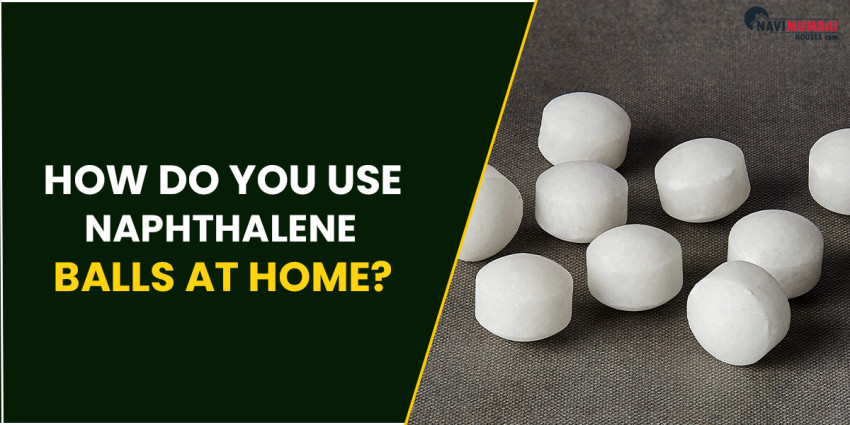
The versatile and often used organic chemical naphthalene is recognised for both its unique smell and a wide range of uses. It has the chemical formula C10H8 and is a white solid at normal temperature. Naphthalene is made up of two fused benzene rings and is a member of the class of aromatic hydrocarbons. Due to its special qualities, it has been used for centuries in a variety of sectors, including building and real estate.
How Do You Use Naphthalene Balls at Home?
The versatile and often used organic chemical naphthalene is recognised for both its unique smell and a wide range of uses. It has the chemical formula C10H8 and is a white solid at normal temperature. Naphthalene is made up of two fused benzene rings and is a member of the class of aromatic hydrocarbons. Due to its special qualities, it has been used for centuries in a variety of sectors, including building and real estate.
The characteristics of naphthalene
Odour
Naphthalene has a strong fragrance, which is one of its most distinctive characteristics. Since it is frequently employed as an ant, insect, and pest repellent, this strong fragrance is frequently associated with mothballs.
Points of melting and boiling
Naphthalene is relatively flammable and has a boiling temperature of around 218°C (424°F) and a melting point of about 80°C (176°F). It is excellent for many industrial operations that require heating and cooling because of these qualities.
Solubility
However, it quickly dissolves in organic solvents like ethanol, benzene, and chloroform. Naphthalene is very weakly soluble in water. It is a great option for usage in many formulations and applications due to its solubility.
Volatility
Naphthalene readily evaporates at room temperature due to its high volatility. When used in enclosed environments, this characteristic helps it function well as an insect repellent.
Naphthalene uses
Using mothballs and pesticides
Because of its capacity to deter insects and prevent harm to clothing and textiles, naphthalene has long been a main component in mothballs. It functions as a fumigant and emits a gas poisonous to pests and insects. However, it is crucial to use naphthalene goods cautiously, according to instructions, and out of the reach of children and animals.
Chemical stepping stone
In the creation of several compounds, naphthalene plays a crucial role as an intermediate. In the production of colours, polymers, resins, and medicines, it serves as a raw ingredient. In addition, synthetic tanning agents and antioxidants are made using derivatives of naphthalene.
Commercial solvent
Naphthalene is used in many industrial processes because of its superior solvent characteristics. It is frequently used as a cleaning agent for tools and machinery as well as a solvent for removing oils from seeds.
Sources of energy and fuel
There are several ways to turn naphthalene into energy. Due to its high energy content and stability, it has been explored as a possible source of renewable energy, particularly for use in fuel cells and batteries.
Investigation and creation
Naphthalene is useful for scientific investigation because of its distinct chemical structure and characteristics. It is commonly used as a model substance for research on organic synthesis, chemical reactions, and aromatic hydrocarbons.
Safety measures
Despite the fact that naphthalene has a wide range of uses, it should always be handled and used carefully. Here are some things to remember about safety:
Ventilation
To reduce exposure to its vapours, naphthalene should be utilised in well-ventilated spaces. This is crucial when using it as an insect repellent or in industrial settings where there may be significant naphthalene concentrations.
Skin and eye defence
To avoid skin contact and eye discomfort when handling naphthalene, it is advised to put on gloves, protective gear, and safety eyewear.
Storage
Store naphthalene away from heat sources and open flames in a cold, dry location. It should be kept out of children's and animals' reach.
Using naphthalene in building and real estate
As an organic substance, naphthalene is not frequently employed directly in the building and real estate sectors. However, various uses for its derivatives and associated goods may be found in particular construction-related procedures. Here are some examples of how naphthalene or its compounds are utilised in the building and real estate industries:
Concrete admixtures
Concrete admixtures of the sort known as naphthalene sulfonate formaldehyde condensates (NSF) are often utilised in the building sector. These additives, commonly referred to as superplasticizers, improve the flow and workability of concrete. They are included in concrete mixtures to lessen the amount of water, boost strength, and prolong the lifespan of concrete constructions. In order to produce high-performance concrete that demands enhanced strength and workability, naphthalene-based superplasticizers are useful.
Aides to waterproofing
Concrete constructions are shielded against water infiltration and moisture damage using waterproofing chemicals or sealants based on naphthalene. These substances provide a barrier that stops water from penetrating the concrete and causing it to deteriorate, fracture, or spall. They are frequently used on roofs, basement foundations, and other water-prone places.
Pesticides for wood
Naphthalene or naphthalene derivatives are the active components in a few wood preservatives. By using these preservatives, timber constructions like fences, decks, and outdoor furniture are shielded against rot, fungal development, and insect infestation. Naphthalene-based wood preservatives offer enduring defence against organisms that damage wood, increasing the life of the treated wood.
Thermal defence
Thermal insulation in construction occasionally involves the use of foams or insulation materials based on naphtha. These foams may be used in walls, roofs and floors because they have strong thermal qualities, which limit heat transmission and increase a building's energy efficiency.
Things to keep in mind
It is crucial to remember that any usage of naphthalene or a derivative in building supplies or goods must adhere to all applicable laws and safety standards. When producing, handling, and using items containing naphthalene, manufacturers and contractors must make sure that the proper safety precautions are followed to safeguard personnel, building occupants, and the environment. When utilising naphthalene-based goods in real estate and construction projects, it is advised to seek expert advice and adhere to industry best practises as with any chemical or building material.
Source From:- navimumbaihouses






